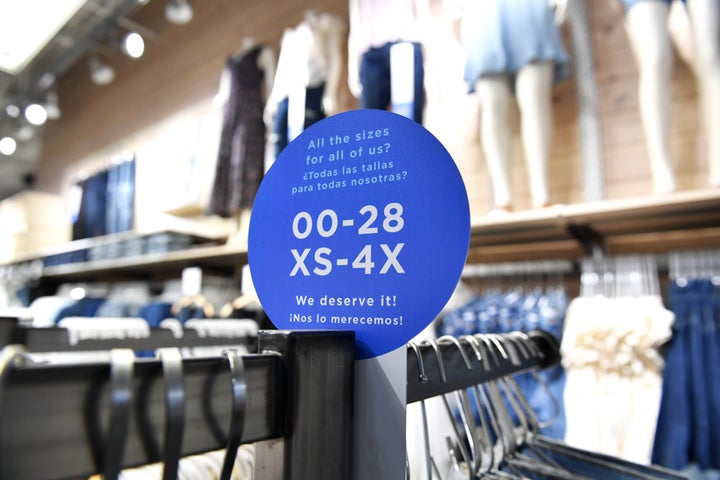
Last week, Old Navy announced its new BODEQUALITY initiative, which it says “democratizes the shopping experience for women of all sizes.” This is set to go into effect Aug. 30, according to the press release, and will make Old Navy the “first value retailer to offer sizes 0-30 and XS-4X for all women’s styles at price parity.”
It will also be eliminating a separate “plus size” section, so shoppers of all sizes will find their clothes in one place. All items will be offered in every size, from 0-30 or XS-4X, the company touts. Additionally, retail spots will have mannequins in sizes 4, 12 and 18 (the third of which, it’s worth noting, is roughly the “average” size of an American woman) throughout the store.
In the release, Alison Partridge Stickney, head of women’s and maternity merchandising at Old Navy, said, “We set out to understand what women of all sizes wanted from fashion and the shopping experience and were inspired to revolutionize every area of our business ― from how we fit and design our products, to how we communicate to customers in stores and online ― to ensure that all women feel welcome and represented.”
If you wear a size 30 or below, you’re likely feeling pretty great about all of this ― or at least most of it. If you read the fine print and wear a size 30, you may feel a lot less excited to learn that size 30 ― and ONLY size 30 ― will not actually be carried in stores. That one size will only be available online.
Limiting its extended size range to online shopping is something Old Navy has long been criticized for, so this is a huge disappointment in a launch that’s supposed to be about inclusiveness and equity. Not to mention, excluding just one size from the stores feels somehow extra insulting.
Mia O’Malley, a plus-size digital creator, pointed out that while this is a “great start,” Old Navy needs to have size 30 in stores ― and also to expand its sizing beyond that. Old Navy’s response was … well, a bit baffling. It replied and said it hasn’t seen a demand for size 30 in stores. Um, OK, but how can you when you don’t offer it? It even suggested popping in to a local store to ask an associate about it.
Yeah, because who doesn’t want to take the time out of their day to visit a store they know doesn’t carry their size to ask a very likely underpaid and/or overworked employee (who is almost certainly going to be smaller than them, just for added insult) to please make a note of the fact that they’d like their size to be carried? Logical thing to expect us fat folks to do, Old Navy.
In fact, if you visit Old Navy’s Instagram post about this news, plenty of other people have since questioned this decision ― including the plus-size model and activist Saucyé West, who has been fighting for fashion inclusivity on Instagram using the hashtag #fightforinclusivity. West has been highlighting brands that have failed at inclusivity (often despite promises to the contrary), while also featuring brands that are doing it better.
She encourages people who can wear brands that fail at inclusivity to boycott them, and with over 51,000 followers, she’s getting noticed. But not by Old Navy ― despite the company answering many, many questions about this questionable choice to not carry size 30 in stores, her comments have, at least thus far, been ignored by the official Old Navy account.
In an attempt to be equitable to yet another brand that isn’t being particularly equitable but is pretending to be, let’s discuss what Old Navy did get right in this launch: Offering every item in every available size, at the same price (though it should be noted that the company seems to imply on Instagram that some items may be “limited,” which I assume means not many are made in larger sizes, and is yet another reason I’m not so sure I support the end of the “plus size” section).
There is no valid reason not to offer every item you carry in every size. There’s also no valid reason, despite claims otherwise, for plus-size clothing to cost more money.
Yes, fat people’s clothing requires more fabric. But the notion that this equates to the kind of markup we typically see in plus-size clothing is bullshit, and it’s been debunked by plenty of indie designers, as well as people who have worked in the industry (and it’s also worth noting that for those unfortunate size 30s, unless every order with a size 30 ships free, this is just another misleading claim, anyway).
This is an issue that Mallorie Dunn, owner of SmartGlamour, has discussed previously. In this Instagram post, Dunn points out that when the majority of shoppers are plus sized, viewing us as an afterthought is a major flaw in a retailer’s business model, saying “if you’re costing off a medium ― quite frankly you’re doing it wrong and you’re losing money on your own accord.”
She further adds that, “If you consider plus size people to be a niche category ― who doesn’t deserve your full attention, full marketing strategy, full focus ― you are losing money on your own accord. Making clothing in XS-XL and then at some point trying to tack on a 1, 2, and/or 3X is outdated and incorrect and the only person to blame is you.”
SmartGlamour’s pricing is the same for every size offered ― an impressive range that runs XXS to 15X, and each item is made to order by Dunn herself, making the brand ethical and sustainable in addition to inclusive. She also offers custom sizing and a wide variety of customization options (these do add to the cost).
Old Navy’s brand of “inclusivity” is, to be honest, more than insulting at this point. It’s infuriating and exhausting. If you’re over a size 30 (28 in stores), you essentially do not exist. That’s what this language tells us.
Returning to the earlier quote from Old Navy, if you are going to claim that you are trying to understand what women of “all sizes” want from fashion, you don’t get to then decide to stop at a size 30.
Of course, people are going to argue that fat folks like me expect too much if we expect every retailer to operate on a model like SmartGlamour’s. To be clear, I don’t expect that. For one, it goes against the entire business model, regardless of sizing, of stores like Old Navy. Mass production isn’t intended to accommodate everybody ― and it never will.
What I do expect, though, is that retailers will consider the harm in their supposedly “equitable” marketing,” in their “inclusive” branding. You can’t claim to be inclusive or equitable when you are literally excluding people over a certain size. It’s beyond disingenuous. It’s a flat-out lie, and what’s really maddening is knowing that they will profit off so many fat people who DO fit into their clothes.
Which is why I find the work of activists like West so valuable. We desperately need smaller fat people and thin people who want to be allies to stand up to these companies. It’s not about asking or expecting them to cater to every single size.
It’s about asking them to stop acting like an entire part of the population simply does not exist. It’s about the erasure of those of us who don’t fit their clothes that are supposed to be for “all” bodies. It’s dehumanizing and demeaning, and those of us in larger bodies already deal with enough of this. Seeing it done in a way that’s celebratory is just salt in wounds that never have a chance to heal.
As for me, I will happily spend my money shopping at brands that actually do offer custom sizing, or that don’t claim “inclusivity” where none exists. I would much rather support brands that actually give a damn about me as a consumer, and I would love if other people felt the same way because ― spoiler alert ― even if you will fit in Old Navy’s new size range, you are fooling yourself if you think they are doing anything but manipulating you with their “inclusive” branding.
This isn’t about equity. It’s about profit, and the sudden, seemingly shocking realization that they can make more money off fat people by exploiting us even further.
Do you have a compelling personal story you’d like to see published on HuffPost? Find out what we’re looking for here and send us a pitch!
